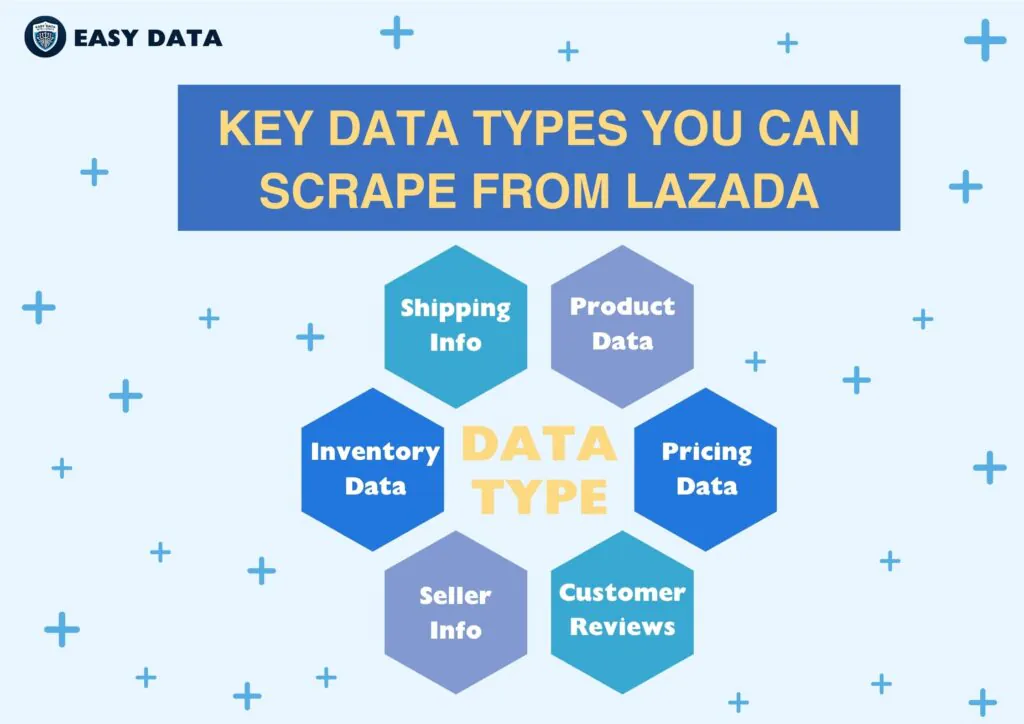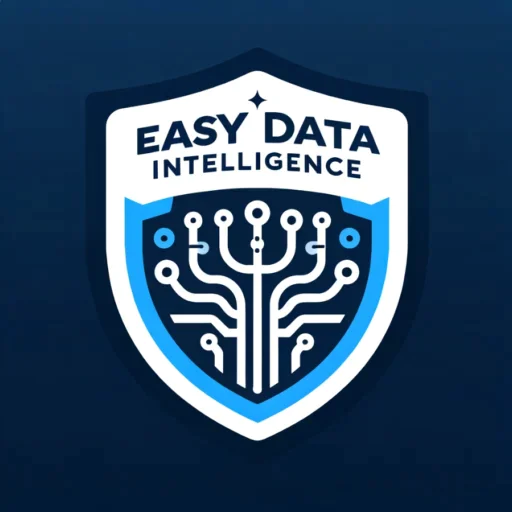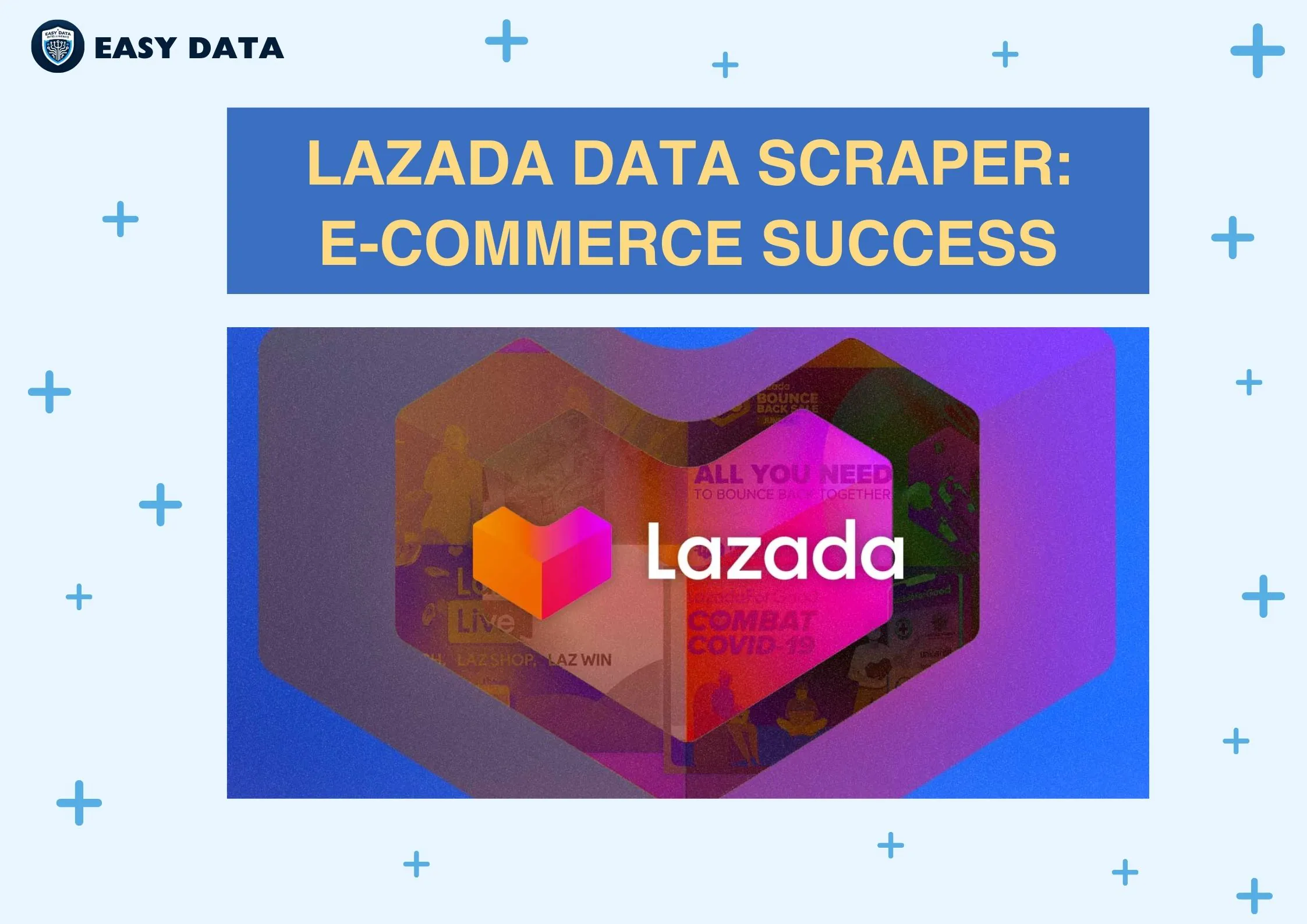In today’s competitive e-commerce landscape, data is the backbone of strategic decision-making and growth. Marketplaces like Lazada, one of Southeast Asia’s top online retail platforms, host an immense amount of valuable data—ranging from product prices and reviews to seller information and market trends. For businesses seeking to stay ahead, access to this data can provide essential insights for competitive analysis, pricing strategies, market research, and customer sentiment analysis.
However, extracting and analyzing this data manually is impractical due to the sheer volume of information available. This is where Lazada data scraping comes in. By using automated tools to scrape data from Lazada, businesses can unlock valuable information in a structured format that’s easy to analyze.
In this guide, we will explore the concept of Lazada data scraping, various tools and techniques to perform scraping, the key data types you can extract, legal considerations, and the significant benefits it can provide for e-commerce businesses. By the end of this article, you’ll have a thorough understanding of how to leverage Lazada’s vast database to make informed decisions and drive your e-commerce business forward.
- What Is Lazada Data Scraping?
- Why Scrape Data from Lazada?
- Key Data Types You Can Scrape from Lazada
- Tools for Scraping Lazada Data
- How to Scrape Lazada Data: A Step-by-Step Guide
- Legal and Ethical Considerations of Lazada Data Scraping
- Benefits of Lazada Data Scraping
- Challenges and Limitations of Lazada Data Scraping
- Conclusion
What Is Lazada Data Scraping?

Lazada data scraping is the process of using automated bots or programs to extract publicly available information from Lazada’s web pages. This could include product titles, prices, descriptions, reviews, seller information, and other relevant details. The purpose of scraping is to convert unstructured web data into structured data that can be analyzed for insights.
Lazada operates in six Southeast Asian countries—Singapore, Malaysia, Indonesia, the Philippines, Thailand, and Vietnam—making it one of the largest e-commerce platforms in the region. As a seller, marketer, or analyst, accessing Lazada’s data can be a game-changer for monitoring trends, understanding customer preferences, and staying ahead of competitors.
Why Scrape Data from Lazada?
Data scraping from Lazada offers a wide array of benefits for businesses that aim to grow, optimize pricing strategies, and improve customer satisfaction. Here are some of the key reasons why businesses choose to scrape Lazada data:
1. Competitive Pricing and Strategy
Lazada data scraping enables businesses to monitor their competitors’ pricing strategies in real time. By tracking product prices, discounts, and promotions across the platform, you can adjust your pricing to stay competitive or set up dynamic pricing models that optimize profitability.
2. Product Research and Selection
Identifying high-demand products is essential for any e-commerce seller. Scraping Lazada allows you to research best-selling products, emerging trends, and gaps in the market where new product opportunities may lie. This information can be invaluable for expanding your product line or optimizing inventory.
3. Market Trend Analysis
By collecting historical data on product listings, sales, and customer reviews, businesses can identify market trends and seasonality. This data can inform decisions around product launches, marketing campaigns, and inventory management.
4. Customer Sentiment Analysis
Scraping customer reviews from Lazada provides insights into how customers perceive products. This data can be used to improve product descriptions, enhance features, and address common pain points. Additionally, customer feedback helps businesses assess product quality and service satisfaction.
5. Seller Performance Monitoring
Lazada scraping also enables businesses to monitor top sellers, track their inventory, pricing strategies, and performance metrics. This helps in benchmarking your own store’s performance and identifying areas of improvement.
6. Efficient Data Collection and Automation
Manual data collection from Lazada’s vast database is both time-consuming and prone to errors. Using a Lazada data scraper automates this process, enabling you to gather large datasets quickly and efficiently, all while ensuring data accuracy.
Key Data Types You Can Scrape from Lazada
Before you begin scraping Lazada, it’s important to understand what types of data are accessible and how they can be leveraged for business insights. Here are some of the most commonly scraped data types from Lazada:

1. Product Data
- Product Name: Scraping product titles helps you monitor various product listings and identify trends.
- Product Description: Understanding how top sellers describe their products can give insights into effective selling techniques.
- Product Categories: Categorization helps businesses track product trends across different segments.
- Product Specifications: Extract technical details or attributes about products for comparison purposes.
- Product Images: Product images can be useful for identifying design trends or conducting visual content analysis.
2. Pricing Data
- Product Price: Pricing data allows for competitive analysis and helps set optimal prices.
- Discounts and Promotions: Track current discounts and promotional offers to adjust your own marketing strategy.
- Historical Pricing Data: Scraping historical price changes provides insights into price fluctuations and discount strategies over time.
3. Customer Reviews
- Review Ratings: Track star ratings for customer sentiment analysis and to gauge product popularity.
- Review Text: The content of customer reviews provides deeper insights into consumer satisfaction and areas for product improvement.
- Review Dates: Analyze review timelines to understand product performance trends and customer feedback consistency.
4. Seller Information
- Seller Name: Monitor top competitors or sellers in your product category.
- Seller Ratings: Scrape seller ratings to benchmark your store’s performance against competitors.
- Number of Sales: Track the number of sales or orders processed by each seller to assess market share.
5. Inventory Data
- Stock Levels: Track product availability and stock levels of competitors to anticipate supply and demand changes.
- Restocking Trends: Analyze restocking patterns of popular products to optimize your inventory management.
6. Shipping Information
- Shipping Costs: Extract shipping cost data to identify the most cost-effective logistics strategies.
- Delivery Times: Scraping estimated delivery times can help in evaluating and optimizing your fulfillment processes.
Tools for Scraping Lazada Data
There are various tools available for scraping Lazada’s data, depending on your technical skills, project scale, and data requirements. Here’s a breakdown of some popular tools and approaches:
1. No-Code Web Scraping Tools
If you’re looking for an easy-to-use solution without the need for coding, no-code web scraping tools can automate the process.
Octoparse
Octoparse is a cloud-based web scraping tool that allows you to build workflows visually, making it easy to scrape Lazada data without any coding knowledge. Octoparse can scrape product prices, customer reviews, seller information, and more. It supports scheduled scraping, so you can regularly collect updated data for your analysis.
ParseHub
ParseHub uses machine learning to scrape data from complex websites like Lazada. It’s especially useful for scraping dynamic content or pages that require JavaScript interaction. With its visual point-and-click interface, ParseHub is user-friendly for non-developers.
DataMiner
DataMiner is a browser extension that allows you to scrape data directly from your browser. It’s ideal for small-scale scraping tasks, like collecting product prices, reviews, or seller information. While not as powerful as other tools, DataMiner is a convenient option for quickly extracting data without setting up complex workflows.
2. Python-Based Web Scraping Tools
For those with programming knowledge, Python-based tools offer flexibility and scalability. You can customize your scraping scripts to extract specific data points and automate the process for large datasets.
BeautifulSoup
BeautifulSoup is a Python library for extracting data from HTML and XML documents. It is often used in conjunction with the Requests library to send HTTP requests and retrieve web pages. BeautifulSoup is a great option for beginners because of its simplicity and readability.
Scrapy
Scrapy is a more advanced web scraping framework built for large-scale scraping projects. It’s highly efficient for crawling multiple pages, processing data, and exporting it into CSV, JSON, or other formats. Scrapy also offers built-in tools for handling common scraping challenges like pagination, dynamic content, and rate-limiting.
Selenium
Selenium is a tool used for automating web browsers, often employed to scrape dynamic content that requires user interaction (such as clicking buttons or scrolling). It’s particularly useful for scraping data from JavaScript-heavy websites like Lazada.
3. APIs
Some platforms offer APIs that allow developers to access data in a structured way. Lazada has an API for sellers, but access is limited to specific data related to your own store, such as order management and inventory updates. The Lazada API doesn’t provide open access to the broader marketplace data, which is why many businesses rely on web scraping tools.
How to Scrape Lazada Data: A Step-by-Step Guide
Step 1: Identify the Data You Need
Before you begin, it’s essential to clearly define the data you want to scrape. Are you looking to monitor competitor pricing? Track customer reviews? Collect product descriptions? Knowing your data goals will help you select the right tools and strategies for the job.
Step 2: Choose the Right Tool or Framework
Based on your technical proficiency and project requirements, choose the right tool for scraping. If you prefer a visual, no-code solution, tools like Octoparse or ParseHub are ideal. For more complex, large-scale scraping, Python-based frameworks like BeautifulSoup or Scrapy are more suitable.
Step 3: Scrape Lazada’s Web Pages
If you’re using a Python-based scraper, you’ll first need to send an HTTP request to Lazada’s website using the Requests library:
Copied!import requests from bs4 import BeautifulSoup url = 'https://www.lazada.sg/shop-laptops/' headers = {'User-Agent': 'Mozilla/5.0 (Windows NT 10.0; Win64; x64) AppleWebKit/537.36 (KHTML, like Gecko) Chrome/91.0.4472.124 Safari/537.36'} response = requests.get(url, headers=headers) soup = BeautifulSoup(response.content, 'html.parser')
Step 4: Extract Data from the HTML
Once you’ve retrieved the web page, you can parse the HTML content and extract the data points you need. For example, to extract product names and prices:
Copied!products = soup.find_all('div', class_='product-card') for product in products: title = product.find('a', class_='product-name').text price = product.find('span', class_='price').text print(f'Product: {title}, Price: {price}')
Step 5: Store Data in a Structured Format
After scraping, the data needs to be stored in a structured format for further analysis. You can use Python’s Pandas library to save the scraped data into a CSV file:
Copied!import pandas as pd data = [] for product in products: title = product.find('a', class_='product-name').text price = product.find('span', class_='price').text data.append([title, price]) df = pd.DataFrame(data, columns=['Product', 'Price']) df.to_csv('lazada_data.csv', index=False)
Legal and Ethical Considerations of Lazada Data Scraping
While data scraping can be incredibly valuable, it’s important to understand the legal and ethical boundaries that govern the practice.
1. Terms of Service (ToS)
Before scraping any website, you should always review the site’s Terms of Service (ToS). Many websites, including Lazada, explicitly prohibit certain forms of scraping. Violating these terms can lead to legal action or being blocked from accessing the platform.
2. Respect for robots.txt
Websites often include a robots.txt file, which tells web crawlers which parts of the site they are allowed to access. Ensure that your scraper respects these guidelines to avoid breaking rules or overloading the website’s servers.
3. Data Privacy and GDPR Compliance
If you’re scraping personal data (such as customer reviews that include identifiable information), you need to comply with data privacy regulations, such as the General Data Protection Regulation (GDPR). Scrapers should avoid collecting sensitive or personal information without consent.
4. Avoid Excessive Scraping
Web scraping bots can put a significant load on servers, especially if they send too many requests in a short period. To avoid overloading Lazada’s servers or triggering anti-scraping measures like IP blocking, use rate-limiting techniques and avoid scraping too frequently.
Benefits of Lazada Data Scraping
Now that you know how to scrape data from Lazada, let’s dive deeper into the tangible benefits it offers for e-commerce businesses:
1. Real-Time Competitive Pricing Intelligence
By scraping pricing data from Lazada, businesses can gain real-time insights into competitor pricing strategies. This allows for dynamic pricing adjustments based on market conditions, helping to stay competitive without sacrificing profitability.
2. Enhanced Product Selection and Inventory Management
Scraping product data from Lazada helps businesses identify high-demand products, monitor emerging trends, and make informed decisions on expanding or optimizing their product offerings. Additionally, scraping inventory levels allows for better inventory management, helping avoid stockouts or overstocking.
3. Improved Marketing and Sales Strategies
By analyzing market trends, customer reviews, and product performance, businesses can fine-tune their marketing strategies to target high-demand products and address customer pain points. Understanding customer sentiment through scraped reviews can help you craft more effective product descriptions and promotional materials.
4. Time-Saving Automation
Manually collecting and analyzing data from Lazada is both time-consuming and prone to human error. Data scraping automates this process, allowing you to collect large datasets efficiently, freeing up time for more strategic decision-making.
5. Better Customer Insights
By analyzing customer reviews and ratings, businesses can gain a deep understanding of consumer preferences, pain points, and product satisfaction. This data can be used to improve product features, enhance customer service, and optimize the overall shopping experience.
Challenges and Limitations of Lazada Data Scraping
While Lazada data scraping offers numerous benefits, it’s not without challenges:
1. Frequent Website Changes
E-commerce platforms frequently update their website layouts, adding new features or redesigning their pages. These changes can disrupt scraping scripts, requiring regular maintenance to ensure they continue to work correctly.
2. IP Blocking and CAPTCHA Challenges
Sending too many requests in a short time frame can trigger anti-scraping measures, such as IP blocking or CAPTCHA challenges. To avoid this, use proxies, limit the rate of requests, or implement CAPTCHA-solving mechanisms where necessary.
3. Data Accuracy
Scraping can sometimes produce incomplete or inaccurate data, especially if the scraper isn’t properly configured to handle dynamic content, pagination, or JavaScript-heavy pages. Testing and refining your scraper are essential to ensure high-quality data.
Conclusion
Lazada data scraping can be an invaluable tool for businesses seeking to grow their e-commerce presence in Southeast Asia. Whether you’re monitoring competitor pricing, conducting product research, or analyzing customer sentiment, scraping Lazada’s data can provide the insights you need to make informed decisions and stay ahead of the competition.
However, it’s essential to approach web scraping ethically and legally, adhering to Lazada’s Terms of Service and respecting data privacy regulations. With the right tools, techniques, and strategies in place, Lazada data scraping can be a game-changer in your e-commerce growth journey.
Ready to start scraping Shopee data? Visit easydata.io.vn to learn more about our data scraping solutions and book a demo today!


Leave a Reply